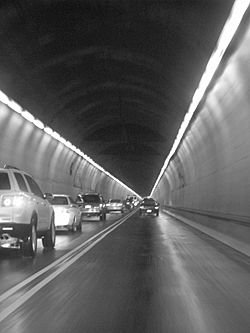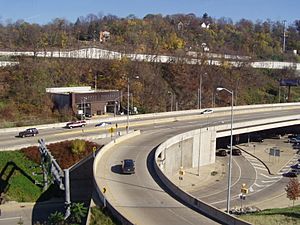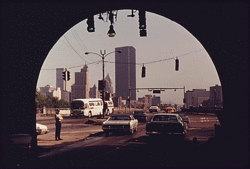Liberty Tunnel facts for kids
 |
|
| Traffic flowing through the Liberty Tunnels | |
| Overview | |
|---|---|
| Location | Mt. Washington, Pittsburgh, Pennsylvania |
| Coordinates | 40°25′45″N 79°59′58″W / 40.429055°N 79.999419°W |
| Operation | |
| Character | Twin Horseshoe Profile road tunnels |
| Technical | |
| Length | 5,889 feet (1,795 m) |
| Number of lanes | 4 |
| Tunnel clearance | 14 ft 6 in (4.42 m) |
The Liberty Tunnels, also known as the Liberty Tubes, are two tunnels in Pittsburgh, Pennsylvania. They help drivers get from the South Hills area to the city center. These tunnels go right under Mt. Washington.
The tunnels were very important for developing the South Hills suburbs. They made it much faster to reach the city. Before the tunnels, people had to travel a long way around or over Mt. Washington. The Liberty Tunnels opened in 1924. They are the longest car tunnels in Pittsburgh. Each tunnel is about 5,889 feet long.
Contents
Building the Tunnels
The Liberty Tunnels were designed by Amos D. Neeld. He also oversaw the building of the nearby Liberty Bridge. This bridge helps drivers cross the Monongahela River after leaving the tunnels.
The tunnels were first designed with two lanes for traffic in each tunnel. They also had a small sidewalk about 4 feet wide. Later, in the 1970s, these sidewalks were removed. This made the traffic lanes wider and taller, which was better for cars.
Other Ideas Before Building
Before the Liberty Tunnels were built, people thought of other ways to get through the mountain. One idea was to dig a very deep cut through Mt. Washington instead of a tunnel. But this plan was not chosen.
Some people wanted tunnels built in an area called Shalerville. Later, in 1959, the Fort Pitt Tunnels were built very close to this suggested spot. Other residents wanted tunnels in a valley behind Mt. Washington. This valley led to towns like Dormont and Mt. Lebanon. This idea was called the Bell Tavern plan. The final plan for the Liberty Tunnels used part of the Bell Tavern idea. It shared the southern entrance but went higher up the mountain. This new path meant a new bridge was needed, which became the Liberty Bridge.
Construction Challenges
The company Booth and Flinn, Ltd. won the contract to build the tunnels in January 1919. Construction started soon after. By May 11, 1922, the main digging of the tunnels was finished.
In January 1924, the Liberty Tunnels officially opened to traffic. The project cost about $6 million at the time. This would be like spending about $100 million today! However, the tunnels were not fully complete. They were missing a very important part: a ventilation system.
Solving the Ventilation Problem
When the tunnels first opened, there was no special system to bring in fresh air. Officials thought that the moving traffic would create enough natural airflow. But on May 10, 1924, a big traffic jam happened inside the tunnels. Cars were stopped and idling, meaning their engines were running but they weren't moving. The fumes from the car exhausts filled the tunnels. Several drivers passed out because of the bad air.
After this incident, officials had to limit how many cars could go through the tunnels. This was for everyone's safety until a proper ventilation system was installed.
With help from the U.S. Bureau of Mines, engineers designed a new system. In 1928, they finished building four tall shafts, each about 200 feet high. These shafts were made to continuously bring fresh air into the tunnels. A special plant was built on top of the mountain to pump this fresh air down the shafts. The shafts themselves stick up about 110 feet above the plant. Once the ventilation system was working, the traffic limits were removed.
Connecting to Liberty Bridge
After the Liberty Tunnels were finished, the Liberty Bridge was completed. It connected to the tunnels on March 27, 1928. The combination of the bridge and tunnels gave drivers and people walking a direct route to the city. They no longer had to go over or around Mt. Washington.
Images for kids




